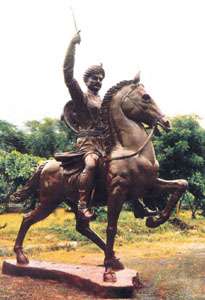Rao Tula Ram
| Raja Rao Tula Ram | |
|---|---|
 | |
| Born |
9 December 1825 village Rampura, Rewari, Punjab |
| Died |
23 September 1863 Kabul, Afghanistan |
| Movement | Indian Rebellion of 1857 |
Rao Tula Ram (circa 9 December 1825 – 23 September 1863) was one of the key leaders of the Indian rebellion of 1857, in Haryana, where he is considered a state hero.[1] He is credited with temporarily driving all of the British rule from the region that today is south-west Haryana during the rebellion, and also helping rebel forces fighting in the historic city of Delhi with men, money, and materiel. Noted as a good administrator and military commander, after the 1857 uprising ended, he left India, met rulers of Iran and Afghanistan, and also established contacts with the Tsar of Russia, to seek their help in driving the British from India. His plans were cut short by his death from dysentery in Kabul on 23 September 1863, aged 38.[2]
Early life
Rao Tula Ram was born on 9 December 1825.[3] His father was Rao Puran Singh,[4] his grandfather Rao Tej Singh[4] and his mother's name was Gyan Kanwar, daughter of Rao Zahari Singh, a local jagirdar.
Rao Tula Ram was one of the great leaders of the Indian Uprising of 1857 against the colonial British forces. His story is one of rebellion and guerilla warfare against the stronger and better-equipped imperialist forces of the British Army.
The battle of Narnaul was undoubtedly one of the most decisive battles of the uprising of 1857. The English felt jubilant over their success in this confrontation, for it resulted in the marked close of the crucial period of the struggle in the Haryana region and northern Rajasthan.[5]
Rao Tula Ram's Istemraree estates were confiscated by the British in 1859, though proprietary rights of his two wives were retained. In 1877, his title was restored to his son Rao Yudhister Singh, who was made head of the Ahirwal.[6]
Legacy
The government of India issued on 23 September 2001, a postal stamp featuring Maharaj Rao Tula Ram.[7] Institutions named in his honour include Rao Tula Ram Memorial Hospital in Jaffarpur Kalan[8] Maharaj Rao Tula Ram Polytechnic Wazirpur Chirag Delhi the Institute for Defence Studies and Analyses at Maharaj Rao Tula Ram Marg.[9][10]
Rao Tula Ram Hospital
Rao Tula Ram Hospital is located near police station in Jaffar Pur and is approachable from Rawta mor of Dhansa Road.[11]
Shahidi mela (fair)
A two-day Shahidi mela (fair) in September is held annually at Rampura (Rewari) to commemorate the death anniversary of Rao Tula Ram, an Ahir hero of 1857.[12]
See also
- Rao Mitra Sen Ahir
- British East India Company
- Mufti Yaqinuddin
- Qazi Mir Imdad Ali
- Syed Mohammad Ashraf
References
- ↑ "Republic Day Celebrations". The Tribune. 28 January 2008.
- ↑ Haryana (India) (1988). Haryana District Gazetteers: Mahendragarh. Haryana Gazetteers Organization. Retrieved 30 September 2012.
- ↑ Sankhdher, B.M (2006-01-01). "Historical Studies on Modern India". ISBN 9788176297639.
- 1 2 Punjab (1883). Punjab gazetteers, 1883,. Oxford University. p. 31. Retrieved 7 October 2014.
- ↑ Prakash, Buddha (1967). Glimpses of Haryana. University of Kurukshetra. p. 110. Retrieved 8 May 2016.
- ↑ Punjabi University (2001). "The Panjab Past and Present, Volume 32". Punjab (India). Department of Punjab Historical Studies, Punjabi University, Original from the University of Michigan. pp. 76, 77, 78. Retrieved 7 October 2014.
- ↑ "Gallery of Indian Stamps - 2001". indiapicks.com.
- ↑ %7CAugust 18, 2012 "Rao Tula Ram Memorial Hospital, Jaffarpur" Check
|url=value (help). - ↑ "The Institute for Defence Studies and Analyses-Contact us". Retrieved 18 August 2012.
- ↑ "Directorate of Trg and Tech Ed. delhi.gov.in". 27 August 2014. Retrieved 7 October 2014.
- ↑ "Directorate of Health Services". Department of Health. Retrieved 30 August 2012.
- ↑ R. K. Upadhyay (1996). Widowed and Deserted Women in Indian Society. India. Dept. of Women and Child Development & Harnam Publications. p. 71. ISBN 9788185247113.
Further reading
- K.C. Yadav, Rao Tula Ram, National Book Trust of India (2008). ISBN 978-81-237-5110-8
- Anil Yadav, 'Krantidoot- Rao Raja Tularam' -Sarita book House(1998)
- Ravindra singh & Vijaypal yadav- "1857 ki kranti k purodha Rao Raja Tularam" puneet prakashan jaipur(2013) ISBN 978-81-88559-54-1